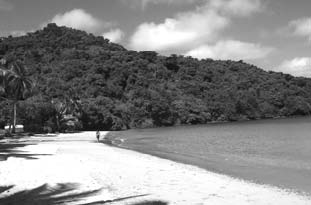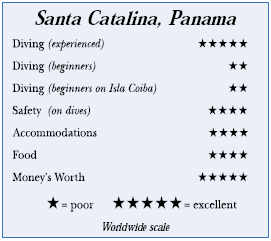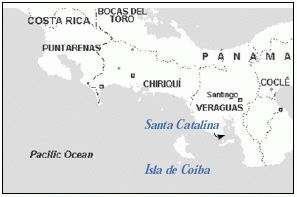Scuba Coiba, Santa Catalina, PanamaContents of this Issue: Scuba Coiba, Santa Catalina, Panama Sporasub Ignores a Subscriber, but Undercurrent Gets Their Attention DAN or Your Computer? When to Fly after Diving Tech Diving, Rebreathers and Wrecks Massachusetts Wreck Plunderer Returns Artifacts Photo Gear, Rebreathers Stolen from Divers Editorial Office: Ben Davison Publisher and Editor Undercurrent 3020 Bridgeway, Suite 102 Sausalito, CA 94965 still unspoiled ... for now from the March, 2006 issue of Undercurrent
Dear Reader: Caribbean countries are easy-to-reach tropical dive destinations, but most have become pricey places to sleep, eat and dive. And, after a few trips, diving begins to look the same. But in December, I spent $600 for five dive days at a land-based operation on Panama’s Pacific side, where not only will one find fish in far greater numbers, but also Pacific species like the golden puffer, Moorish idols, Pacific nurse sharks and zebra morays. While only a three-hour flight from Miami, the downside is a long drive from Panama City to the Pacific coast. My hotel was pleasant, diving services were simple but good, and tourism is still a dream. Here serious divers in search of an adventure will find one.
For five days I hooked up with Scuba Coiba in Santa Catalina (pop. 348), 205 road miles from Panama City. Owner Herbie Sunk, an Austrian émigré, answered my emails promptly, making planning easy. While my dive buddy and I considered renting a car rather than risk sharing the road with Panamaniac drivers, we decided to fling our dive bags on top of provincial buses. More fun to admire cecropia trees, parrots and coffee plantations, wave at horseback riders along the roads and chat with locals than clutch a steering wheel and dodge potholes. Of course, renting a car would be more convenient and much faster. The bus dropped us at the Sol y Mar hotel, a quartermile from the dive shop. Owner Luís Silva, an energetic, multilingual 37-year-old Portuguese, loaded our luggage into his pickup and drove us up the hill to one of three duplexes surrounded by fruit trees and flowers and parrots streaking above the forest canopy. “We just finished this unit. You’re only the second persons to occupy it,” he said as we crossed a large porch with space enough to hang wet things. I stepped into the large tile-floored living room, tossed my bag on one of two double beds in the bedroom and stowed my water bottle in the mini-fridge. Luís showed us how to work the satellite TV, A/C and instant hot water in the shower. I plugged my battery charger into a 110-volt outlet and joined Luís and our dive bags for a ride to Scuba Coiba. Along the way, he pointed out eateries (Sol y Mar has no food service), markets, and the town’s only telephone (which hadn’t worked for two months), all within walking distance. Scuba Coiba is housed in a two-room concrete building on a public beach, where Herbie checked our C-cards. We set up our gear and Herbie promised, “We’ll take it to the boat and unload it after the dives. We’ll rinse it, hang it to dry and set it up every morning.” The next morning no restaurant opened before 7:45 A.M., since workers had partied late in the cantinas. My buddy and I plus David, another diver staying at Sol y Mar, took one of four tables in a no-named restaurant on the corner with the phone booth and waited. Mike, an ex-pat from California, joined us and assured us that our divemaster, English expat Rachel Fulton, whom we were to meet at 8 A.M., would understand. “This is Panama time,” he said. Eventually, someone took our orders -- all they could muster up was beef stew with leftover rice. But it was food and cheap -- $2.10 -- so I stoked up for the dives. At the shop, our dive gear had been set up in a 15-ft. outboard-powered lancha (not the regular dive boat) and in 20 minutes we dropped anchor at Snapper Point, at a precise site located by Rachel’s GPS.
Our second dive was at Los Pelones, an island nearly devoid of trees. As I descended the anchor line, a flock of spotted eagle rays glided above. Again, splendid fish action, plus green and brown morays that squirmed around the rocks. The next day, we departed at 8 AM for the Isla Coiba National Park archipelago in the 21-ft., canvas-covered Ingrid. Ninety minutes later, we stopped at Frijoles, the first of three dive sites. We again descended on the anchor line through modest current, landing near a lazing whitetip reef shark. Beneath a ledge, two large lobsters were mating. And wow, the fish on the 55-minute drift could fill a fish ID book: two jeweled morays with white heads and yellow barbs, several golden pufferfish in both yellow and black-and-white dotted stages, two skittish barracuda, schools of king angels, and porcupine fish, guineafowl puffer, trunkfish, roosterfish, yellow butterfly fish, pargas, grouper, bluefin jacks, parrotfish, blunt head triggerfish who, when swimming sideways, resembled turtles, a trio of Moorish idols, all in nearly 100-foot viz. During our drifting safety stop, three long toms cruised above, looking like fat trumpetfish, while Captain Marco Alfonse kept the Ingrid nearby. Upon surfacing, I handed up my weight belt and tank, then hauled myself over the side of the ladder-less boat, with a hand from Luis when I didn’t make it on the first attempt. Anchoring off the Ranger Station for our surface interval, Rachel cut pineapple for snacks, then we visited the biological station, visitor center, bunkhouse and kitchen. Our second Isla Coiba dive was at Mali Mali, named after an island guide, a former Coiba prisoner. (Before it became a wildlife refuge in 1991, Coiba Island served as General Noriega’s equivalent of Siberia for political prisoners. The prison closed in 2002.) Two green turtles swam past and Rachel pointed out sharks in a cave, their white-tipped tails poking out. So many fish swam over, under and around us that I gave up naming and counting and just enjoyed them. Between the second and third dives, Rachel served turkey sandwiches and fruit. During the next three days, we visited several sites near Isla Coiba, and others closer by. I swam with hundreds if not thousands of the fish I’ve mentioned, plus spadefish, sergeant-majors, surgeonfish, doctorfish, trumpetfish, silversides, pargas, rainbow wrasses, blennies, gobies, long-nosed hawkfish, zebra morays, brown and green morays (one perhaps seven feet long), eagle rays, marble rays, whitetip sharks, and Pacific nurse sharks. I hadn’t seen this much quantity or variety since in Palau. Thick clusters of fan, brain and lettuce corals vied for space on the volcanic rocks with sea fans and sea whips and gorgonians waved in the occasional current. The landscape reminded me of the Caribbean, except the viz. wasn’t quite as clear. A red filter on my camera brightened everything. Rachel pointed out several scorpionfish, indistinguishable to me from their green and brown rock surroundings and two motionless yellow and one red frogfish. Two delicate harlequin shrimp were barely visible under a ledge. Rachel’s leisurely pace allowed time for photography and dives were just short of an hour. Restrictions? Return with no less than 1000 psi – aluminum 80 fills exceeded 3000 psi – and don’t exceed your computer’s no-decompression limits. Santa Catalina is sleepy, so après-dive action meant strolling through town (only one road is paved), practicing Spanish with shy, giggling kids, checking out the world-famous surf, or hoping the satellite Internet was working. Or, joining locals at the cantinas, open air, concrete block, cement-floored watering holes with room for dancing to very loud recorded music, few tables and lots of beer. What Santa Catalina lacks in tourist amenities, it makes up for in friendliness. “Stay a few hours and you’re a local; stay overnight and you’re a friend,” said an American ex-pat who came for the surfing three years ago and never left. One warm (77ºF) mosquito-free equatorial night, we and an Israeli couple from next door joined Luis and his wife for dinner. Glowing flames from a wood-fired grill and the aroma of sizzling meat welcomed us to Los Pibes, an Argentine restaurant on one of the hills. Like all Santa Catalina’s restaurants, Los Pibes serves outdoors on wooden planked tables. Over platters of grilled beef, pork, chicken or fish ($5-$8, beer $1), Luís and his buddies talked about the booming real estate market. “There was no paved road when I bought here in 1992,” he recalled. “Land was ten cents a square meter. Now it’s $10 -– if you can find it. Tourism is coming fast. Santa Catalina will not be like this for long.” Small town isolation can create hardships. At the end of one dive, David was handing up his tank when it slammed down on his hand, lacerating a finger. My dive buddy, conveniently a surgeon, said his finger required stitches. He poured hydrogen peroxide on the wound, bandaged it, and we headed back, our third dive aborted. Because there are no medical facilities in Santa Catalina, we drove to the next village, Hicaco, but it was Saturday and the clinic was closed. Finally in Soná, 66 miles away, we found a hospital with an emergency room, doctors and the much-needed stitches – all for $4. Rachel’s fluent Spanish facilitated David’s treatment because he spoke none. He did, however, understand, “No más buceo” (“No more diving for you!”). Still, the lack of amenities adds to the charm. Divers in the 1970s had similar
adventures all over the Caribbean and Pacific. The experiences were deeper,
richer and more memorable than sitting in a dive hotel, where the 42-foot boats
hold 25 divers and the greatest distance one walks is 50 yards to the hotel restaurant.
It’s not that I don’t go to dive resorts, but this was a special trip,
not only with excellent diving, but also with simplicity and adventure uncommon
these days. PS: Thanks to the surfers who have been coming here for years, you can get by without knowing Spanish, but it’s helpful to know some. My Spanish is college-level, but I was constantly asking the locals to speak slower because they spoke rapidly and dropped final syllables. David speaks virtually no Spanish, but claims he gets by anywhere in Central America with pantomime and pointing. – L.Y.
|

I want to get all the stories! Tell me how I can become an Undercurrent Online Member and get online access to all the articles of Undercurrent as well as thousands of first hand reports on dive operations world-wide
| Home | Online Members Area | My Account |
Login
|
Join
|
| Travel Index |
Dive Resort & Liveaboard Reviews
|
Featured Reports
|
Recent
Issues
|
Back Issues
|
|
Dive Gear
Index
|
Health/Safety Index
|
Environment & Misc.
Index
|
Seasonal Planner
|
Blogs
|
Free Articles
|
Book Picks
|
News
|
|
Special Offers
|
RSS
|
FAQ
|
About Us
|
Contact Us
|
Links
|
3020 Bridgeway, Ste 102, Sausalito, Ca 94965
All rights reserved.


 Rachel, small but ballet-dancer muscular, checked the current then briefed us on the site and getting in and out of
the ladder-less boat. I flipped backward,
descended on the anchor line through
a slight current and followed her down 90
feet. The white sandy bottom was punctuated
by rocky outcroppings and covered in
healthy hard and soft corals. Schools of
snappers surrounded me, as did schools of
small yellowtail tuna, and brown and scissortail
chromis. King angels, damsels,
wrasses, banded and spotfin butterfly
fish, and amberjacks were everywhere. In
the78ºF. water we drifted slowly for nearly
an hour, enjoying an infinite array of
fish. Anchoring off a deserted beach for
an hour-long surface interval, we chased
hermit crabs and snacked on fruit from the
local grocery.
Rachel, small but ballet-dancer muscular, checked the current then briefed us on the site and getting in and out of
the ladder-less boat. I flipped backward,
descended on the anchor line through
a slight current and followed her down 90
feet. The white sandy bottom was punctuated
by rocky outcroppings and covered in
healthy hard and soft corals. Schools of
snappers surrounded me, as did schools of
small yellowtail tuna, and brown and scissortail
chromis. King angels, damsels,
wrasses, banded and spotfin butterfly
fish, and amberjacks were everywhere. In
the78ºF. water we drifted slowly for nearly
an hour, enjoying an infinite array of
fish. Anchoring off a deserted beach for
an hour-long surface interval, we chased
hermit crabs and snacked on fruit from the
local grocery. Go forth now, because friendly Santa Catalina may not remain pristine
for long. And the diving is well
worth the trip.
Go forth now, because friendly Santa Catalina may not remain pristine
for long. And the diving is well
worth the trip.  DIVER’S COMPASS: Delta, American, and Continental Airlines fly
from the US to Panama City; fares start less than $700 ... Hertz,
Avis and major car rental agencies are at the airport ... Herbie
can arrange transportation ($180) or take a bus or a combination
of bus and taxi (five to seven hours on mostly paved roads) from
the Terminal Nacional Balboa, a full-service tourist facility, 45
minutes from the airport. Bus fares are $25 to Santiago or Soná,
where you change to the Santa Catalina bus or get a taxi for $60.
Buses vary from converted US school buses with open windows to 24-
passenger liners with restrooms, A/C, and DVD player up front ... US dollars are
interchangeable with Panama Balboas and in small towns and Santa Catalina cash is
the only currency; no credit cards ... Scuba Coiba charges $60 for two tanks, $70
with rental gear; 3 tank trips to Coiba are $140, minimum four divers. Night diving
is done only in Coiba with a 2- or 3-day overnight trip staying at the Coiba
Ranger Station ($330 pp for a 2-day package; $360 with equipment). Scuba Coiba has
rental equipment for eight divers and can handle 15 with their own equipment. No
Nitrox or shore diving ... Viz averaged 50 feet on local dives; 75-100 feet on
Coiba dives ... Nearest recompression chamber is in Panama City via helicopter ...
Herbie emailed me that he now has a six-passenger, 25-foot boat, with an 80-hp
Yamaha outboard, tank racks, radio, GPS, fishfinder, cell phone, medical O2 and a
ladder ... Check
DIVER’S COMPASS: Delta, American, and Continental Airlines fly
from the US to Panama City; fares start less than $700 ... Hertz,
Avis and major car rental agencies are at the airport ... Herbie
can arrange transportation ($180) or take a bus or a combination
of bus and taxi (five to seven hours on mostly paved roads) from
the Terminal Nacional Balboa, a full-service tourist facility, 45
minutes from the airport. Bus fares are $25 to Santiago or Soná,
where you change to the Santa Catalina bus or get a taxi for $60.
Buses vary from converted US school buses with open windows to 24-
passenger liners with restrooms, A/C, and DVD player up front ... US dollars are
interchangeable with Panama Balboas and in small towns and Santa Catalina cash is
the only currency; no credit cards ... Scuba Coiba charges $60 for two tanks, $70
with rental gear; 3 tank trips to Coiba are $140, minimum four divers. Night diving
is done only in Coiba with a 2- or 3-day overnight trip staying at the Coiba
Ranger Station ($330 pp for a 2-day package; $360 with equipment). Scuba Coiba has
rental equipment for eight divers and can handle 15 with their own equipment. No
Nitrox or shore diving ... Viz averaged 50 feet on local dives; 75-100 feet on
Coiba dives ... Nearest recompression chamber is in Panama City via helicopter ...
Herbie emailed me that he now has a six-passenger, 25-foot boat, with an 80-hp
Yamaha outboard, tank racks, radio, GPS, fishfinder, cell phone, medical O2 and a
ladder ... Check 